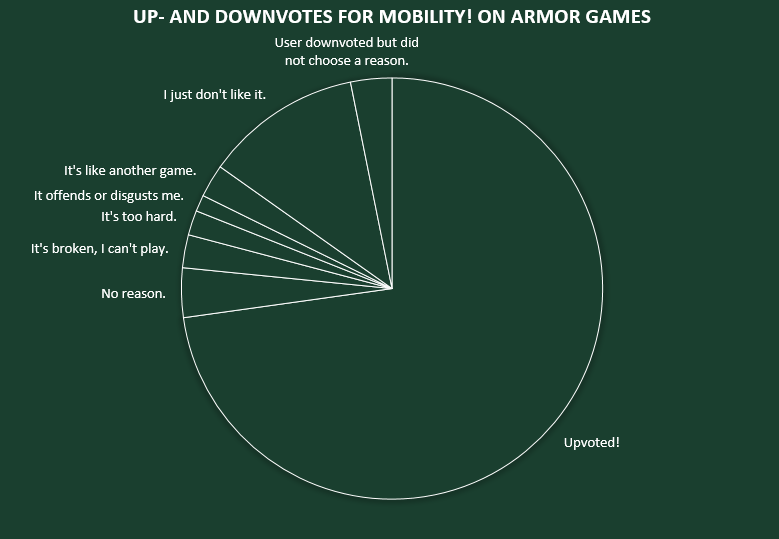Trending
Opinion: How will Project 2025 impact game developers?
The Heritage Foundation's manifesto for the possible next administration could do great harm to many, including large portions of the game development community.
Two years ago, I had an idea for a platforming game. Would my design skills finally be good enough to make a game that would reach an audience? Little did I know that the game’s reception would go well over any expectations I had.

Mirrored from my blog: https://auroriax.com/mobility-the-postmortem/

Two years ago, I had an idea for a platforming game. I love the genre, and it wasn’t the first platformer I had made. I had already made a dozen games, from jam games to multi-month projects, but none of them really managed to get a lot of attention. Would my design skills finally be good enough to make a game that would reach an audience, unlike my previous twelve games? Little did I know that it would take more than two years to get the game to release, and even less that the game’s reception would go well over any expectations I had.

Originally, I had three ideas for a platformer: Hit every platform, get within a radius from them, or disappear after collision. While I was prototyping these three, I realized they were all nice to play, and allowed players to choose the difficulty that suited them best. I was aware of game accessibility, and this helped me to differentiate Mobility from other precision platformers, simply by allowing players to control the difficulty more fluidly. This became the main selling point that I used to promote the game, for example in its trailer.
It took two years from that initial prototype to the final game. In the meanwhile, I kept a devlog of the game. Now I can refer back to decisions made during development, and gathered over 3000 views. It also allowed me to recruit Luke (who did the music for Mobility and my puzzle game Tahira’s Tower), as well as get noticed by Leaf, the lead developer of itch, who would put the game on itch’s home page upon release.
What happened over those two years of development? The game was almost content complete after one year. After that, polishing! Particles, interfaces, movement tweaking, dialog, art, code, camera movement, playtesting, unlockable characters… In retrospect, most of these wouldn’t really be necessary, but I don’t necessarily regret it—Mobility has taught me a lot about developing and finishing a game, and the experience will help me avoid feature creep on my next project.
Some other tips from me: make sure you know how to pitch your game. Your game name, description and thumbnail are your pitch on a game portal. That’s why the game got the “Accessible precision platformer” subtitle, and a gameplay GIF as thumbnail. Make sure you show what’s cool right away—first impressions are important! Next, get players started with the game quickly: optimize the file size, and make a browser version so players don’t have to download. Simply put: reduce the friction as much as possible, and get to the cool stuff more quickly.
Playtesting frequently was part of that progress, and I wrote about that here as well. In summary, test during every major design iteration, and prepare a structure so you can set up playtests and get feedback as quickly as possible. Make tons of notes, and make sure you don’t make the wrong conclusions from your feedback.

Chances are that Super Meat Boy is the first thing that comes to mind when you think about a precision platformer. That was my anti-example for Mobility—it’s masochistic and very, very difficult. That’s why the difficulty selection per level is so important—it allows players greater control over their level of challenge. Players can use it to negate difficulty spikes or dips, or really in whatever way they like. You can still make the game super hard, but only if you really want to.
Another important choice is the ability to play the levels of a world in any order you’d like. I can still control which levels are more likely to be played first (placing them closer to the world entrance), and generally, the harder levels are in later worlds. If there’s a level a player can’t beat, they can decrease the difficulty, or move on—they are told they don’t have to beat every level to progress in the story.
The settings provide some extra settings for those who like it. Players can enable a slowdown that allows them to have a larger timing window. Or they can change the dialog font—the text is already quite big in those, but this can be an extra help for people with dyslexia. Or disable the parallax backgrounds, for those who need higher contrast between gameplay and set dressing or experience motion sickness easily. Button remapping is also a really helpful option in Mobility, but one that was hard to implement properly.
But there are also tools for completionists available in-game! The global game timer allows people to time their speedruns, and can also enable a display of which buttons are pressed and which state their character’s movement is in. There are some cheats as well…

I hope you love stats. I do. Let’s dig through them, and see what we can find.
Here are Mobility’s pageviews & downloads on itch.io so far. The game’s page has 5200 views (and hosts the browser version), and sits at 700 downloads, and was included in one hundred collections.

Most of the traffic and impressions on itch.io actually came from itch itself, the home page in particular. Other traffic comes in from the people searching for html5 or browser games. A problem with pageviews on itch.io is that they don’t distinct page visitors and players of the browser version. If I had known how many people would play the game, I would’ve added a basic analytics system to track how far people would get. Mobility gained me 50 followers on the platform that I can notify when I push out a new game.
GameJolt’s stats are also pretty interesting. It has less page views (around 2800) but more downloads (~1600), meaning the game’s played one in every two page visits! Here’s the graph (page views only for this one):

Notable is the amount of Brazilian visitors: per five US visitors, there’s one Brazilian visitor, making it the second most visiting country. I obtained fifty followers on this platform as well, so my reach overall has expanded quite a bit by releasing Mobility. It’s average rating is a 4.1 based on 47 votes.
After release I got the offer to put the game up on Armor Games. Uploading it there resulted in a lot of new eyes on the game, a lot of honest feedback in the comments. I don’t have graphs for the 40.000 pageviews on Armor Games, but I do have a breakdown of it’s ratings: 115 up and 43 down.

Note the “I just don’t like it” votes. Mobility is certainly not a game that will appeal to everyone, no matter how accessible I’ve intended it to be. Other than that, the upvotes have resulted in a rating of 7.3/10 that I’m really happy with.
I spent most of my free time over two years making Mobility. It probably shouldn’t have been free, but since I’m financially stable & in order to make it as accessible as possible, I chose the pay-what-you-want sale model. On the store page, I put this text:
“I made this game over two years, in my free time during my game design study. While I am not charging for this game, if you enjoy it consider voting with your wallet to support me with making more games in the future.”
There’s also a similar text in the game’s credits, and a “Donate” option on the settings menu. The suggested amount to donate was $5, and over eight donations, the game made around $50 this way. This probably doesn’t seem very impressive—but for me, it made Mobility my first true success. And to be frank, this isn’t even the thing that impresses me the most.
And I wouldn’t forget to mention the list of lovely comments placed on Mobility’s itch.io, GameJolt, and Armor Games pages. Over a dozen Youtubers, voluntarily playing and recommending my game. Armor Games, wanting to pay $300 for a sponsored version of my game on their site, and the resulting exposure. A Brazillian (!) art exhibition wanting to showcase Mobility at their yearly games festival. Someone speedrunning the game properly. And the list goes on.
The response has been overwhelming. I had hoped releasing Mobility would’ve allowed me to relax a little, regain some free time. I underestimated how much emotional impact (both positive and negative) releasing this would have on me. I’m doing fine, but I haven’t gotten started on a new project that quickly as a result.

I’d love to dive a little deeper into Mobility’s analytics in a future blog post, once it’s long tail has become evident. I’m still working on translating Mobility, but no news on that yet (if you want to help with that, check here). I’d also love to talk about the trailer sometime, too.
And like I mentioned before, I doubt I’m interested in doing another two-year development cycle. It’s draining and really hard to keep up motivation for such a long period of time. There are times I just had to take a break of working on it, for example to work on another game. Being creative on command can be really hard and draining.
I’d love to dive into more experimental games. Mobility was an attempt to make something I like a lot, and twist that a bit to make it more accessible. My next personal project will probably not be very game-like as to appeal to an audience that normally doesn’t really play traditional video games.
And I really do want to try my next game to be commercial. I think my game design skills, as well as being able to make a game that actually has an audience, has finally developed enough to be able to try this next. This might be contradicting my previous two points, but finding a way to make these three work together will be my next big challenge.
But perhaps… You’ll still see more of the Mobility in the future. In the meanwhile, you can play Mobility on itch.io, GameJolt, and Armor Games. Or check out the website.
Read more about:
BlogsYou May Also Like